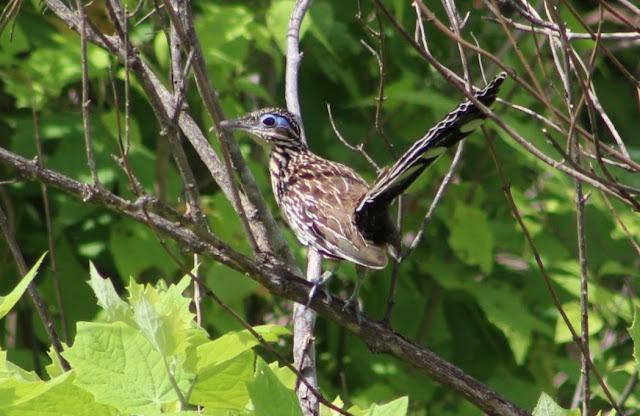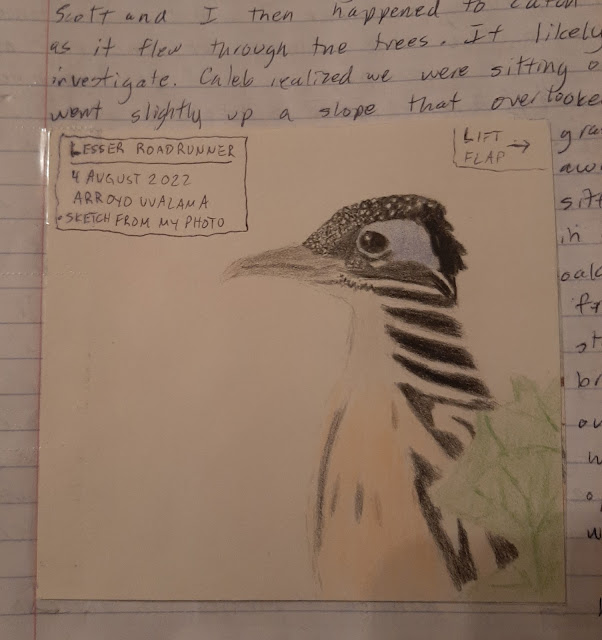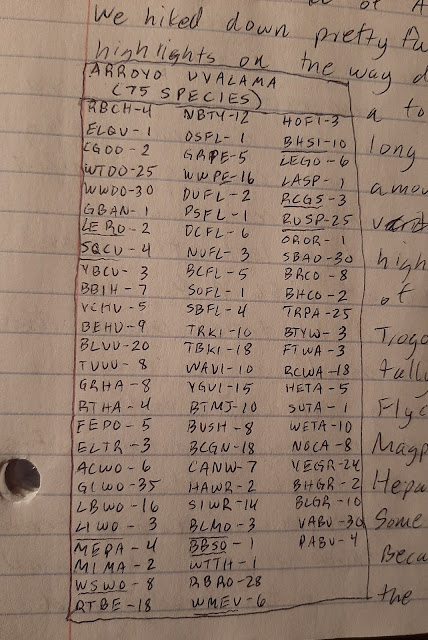After the Ground-Sparrows, we came to an open, grassy spot that is used as an occasional helicopter landing spot. At this point, we had come about 4 miles, and we had another mile to climb. The remainder of the outbound hike was to be very steep, as we would go from oak woodland up to stands of pine and oak. We'd walk for a minute, and then have to catch our breaths for another minute. The secnery got more and more awesome as stunning views were everywhere. Palm trees were present in some places where there were cliffs. There were more an more White-striped Woodcreepers and Rusty Sparrows. Berylline Hummingbirds were also present, which was a fun highlight. When we really stared to hit more pines as we climbed, another lifer appeared in a Black-headed Siskin. This is a cool-looking bird, and there were a few that gave us good views. Black-headed Siskins are found in pine/oak woodlands where we were in northwest Mexico, and their range is scattered throughout Mexico and northern South America. We ended up tallying 10 Siskins, and Caleb even found a nest about 20 feet up in a pine tree. In the same general area was a patch of thick trees with a thick understory. What we thought was calling was what we thought was a White-throated Thrush at first, but it turned out to be my lifer Blue Mockingbird. The sight of this bird was epic, and it's blue coloration and black mask really stood out. True to it's nature, this Blue Mockingbird was a skulker and was hard to get looks at most of the time although it gave me a good binocular look for a few seconds. It ended up having a second mockingbird with it. Most of this bird's range is in west Mexico, with some of the range being in east Mexico. Blue Mockingbirds have strayed to the U.S. as vagrants and have been found in Arizona, New Mexico, and Texas.









 |
| Berylline Hummingbird |
 |
| A poor shot of a Blue Mockingbird |
 |
| Black-headed Siskins |




As we were high up this mountain and almost to the top of where we were able to go, we were having a great time. Bird highlights continued to be many. Things got really fun when a pair of Military Macaws flew right by us at freaking EYE LEVEL! They gave their loud calls as they went by, and the sight of them with the panoramic views of the surroundings behind them was incredible. They are truly a majestic, beautiful bird. Up in the pine/oak we had more Rusty Sparrows and White-striped Woodcreepers. Western Wood-Pewees were common, we had 5 Greater Pewee, and there was also a single Olive-sided Flycatcher. One of the birds we really wanted to see, the Gray-crowned Woodpecker, eluded us for the hike. Maybe next time, as this species prefers pine and oak for it's habitat. When we reached our ending limit we were already exhausted, and we had drank over half of our water. At this ending point the scenery got even more epic as we looked down on about every surrounding. The weather got cloudy and the clouds became level with us. When we started working our way down the birds continued to be active and we took our time. During a break I spent more time listening to and getting a few more glimpses of the pair of Blue Mockingbirds. When we hit a drainage in midst of the pine/oak forest, Caleb exclaimed, "Brown-backed Solitaire in song!" It was heard to hear over three people walking down a steep trail, but we paused for a few minutes and listened. The Brown-backed Solitaire picked up it's song again, that song that is filled with amazing notes and different pitches that pause and continue. There is nothing else in the bird world that sounds like it. It sang twice when we tuned in, and stayed down in the drainage well off trail. Scott was able to catch a glimpse of it, and for me it was a hared only lifer, my 9th lifer of the hike. As we listened to it, Caleb made a good point in saying, "Brown-backed Solitaire is a perfect lifer to get as a hard only". The sound of it was epic enough and it was a great way to get it as a lifer, and views of the bird can wait for another time. Brown-backed Solitaire ranges from northern Mexico to northern South America, and it has been found in Arizona a few times and the records have been accepted (they are kept as cage birds often, a good thing to consider before accepting a record).











 |
| Military Macaws |
 |
| White-striped Woodcreepers |
 |
| Olive-sided Flycatcher dwarfing a Western Wood-Pewee |






After a steep climb down the trail in the higher elevations as we headed back down, we decided to take a quick break at the open grassy area that is that occasional helicopter landing spot. After going near to the top of the Sierra De Alamos, a few breaks here and there were needed. We had heard another Squirrel Cuckoo calling up on a slope, and we were also going to spend a few minutes watching for it. Things got interesting when Caleb thought he had heard a Lesser Roadrunner calling from the slopes above us. We stopped, listened, and....heard it. And we heard it again. The Lesser Roadrunner sounds similar too, but yet different in ways than Greater Roadrunner. We played our tape some and we sat in the open grassy clearing and waited. Thick trees and shrubby understory surrounded the open clearing. Scott and I then happened to catch a glimpse of a Roadunner as it flew though the trees. It was likely coming in to investigate. Caleb realized we were sitting out in the open and we then went slightly up a slope that overlooked the edge of the open grass. We were about 50 feet away from where we were sitting at first, and we were now in better comer and under some oak trees. Minutes later, a freaking LESSER ROADRUNNER started to come out of the brushy habitat! It walked out onto a limb and then walked right out into the open grass, close to where we were sitting. We had killer views, views that were hard to grasp that were actually happening. The Lesser Roadrunner behaved like a typical Greater Roadrunner, but it is a bit smaller, and has a "cute" look to it. It walked through the grass and perched on an open log right in front of us. And things quickly got interesting when a second Lesser Roadrunner emerged from the thick habitat and joined the other At one pint, the pair sat on the same log. What a freaking incredible experience it was. The Lesser Roadrunner ranges throughout most of Western Mexico (southern Sonora at northern limit) and down to Central America. Aside from being smaller than Greater Roadrunner, Lesser Roadrunner has an unstreaked throat area. It was my 10th lifer of this Arroyo Uvalama hike. After the Roadrunners, we celebrated by calling the Squirrel Cuckoo in. It came in slowly, and eventually gave us great views. Two great birds, all by sitting in one spot!
 |
| Lesser Roadrunner!!! |
 |
| The well-named Squirrel Cuckoo! |


The hike of Arroyo Uvalama was nothing short of incredible. We hiked down pretty fast and didn't bird as much. One of the highlights on the way down was a White-throated Thrush. We had a total of 75 species on the hike. With as long of a hike as we did and with the amount of habitats covered, it called for a variety of birds There were many highlights, and I wasn't able to mention all of them. Other highlights included Elegant Trogon, Acorn Woodpecker, Mexican Parrotlet, a nice tally of 18 Rose-throated Becard, 3 Nutting's Flycatcher, up to 15 Yellow-green Vireo, Black-throated Magpie-Jay, Happy Wren, many Sinaloa Wren, 5 Hepatic Tanager, and many Yellow Grosbeak. Something else cool was observing a Rose-throated Becard nest and Streak-backed Oriole nest in the same tree close to each other. After starting the Arroyo Uvalama hike at
4:47 A.M., we finished just over 12 hours later when it was almost 5 P.M. It was one of the best hikes I've ever done and the birding was worth it. But the hike exhausted me and would for the following days to come. 10 lifers made the hike all the more epic. We went to town not long after the hike and got a lot of food. We were starving. What a day.
 |
| White-throated Thrush |
 |
| Streak-backed Oriole and Becard nest neighbors |
From the Birding Journal:





























































No comments:
Post a Comment